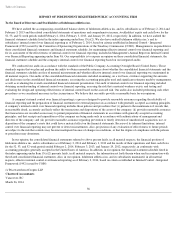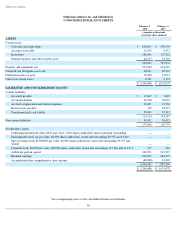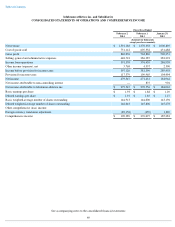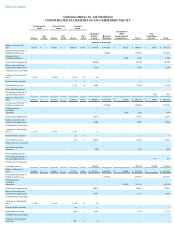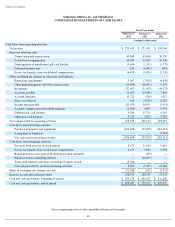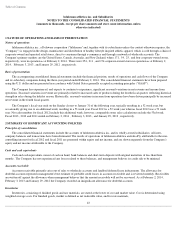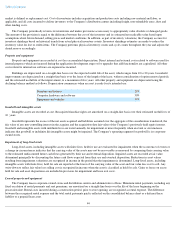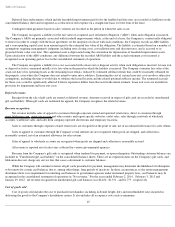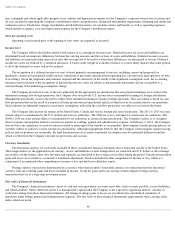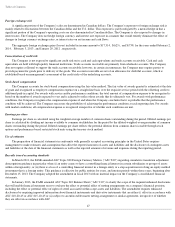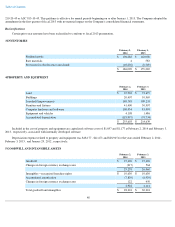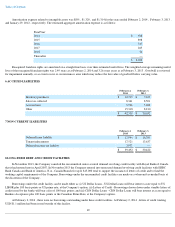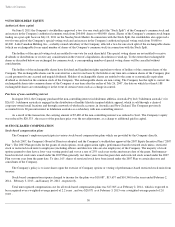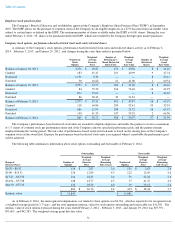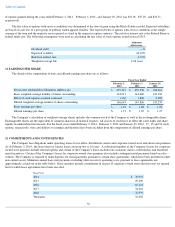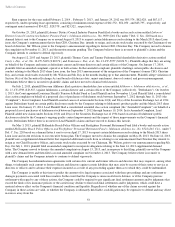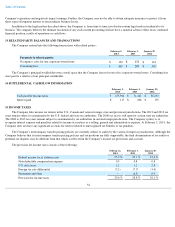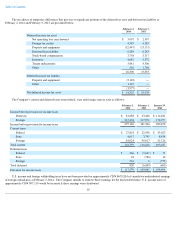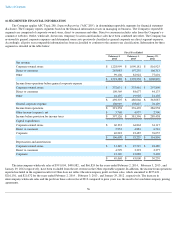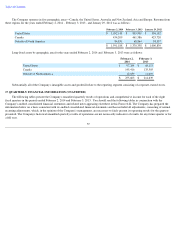Lululemon 2013 Annual Report Download - page 55
Download and view the complete annual report
Please find page 55 of the 2013 Lululemon annual report below. You can navigate through the pages in the report by either clicking on the pages listed below, or by using the keyword search tool below to find specific information within the annual report.
Table of Contents
Foreign exchange risk
A significant portion of the Company's sales are denominated in Canadian dollars. The Company's exposure to foreign exchange risk is
mainly related to fluctuations between the Canadian dollar and the U.S. dollar. This exposure is partly mitigated by a natural hedge in that a
significant portion of the Company's operating costs are also denominated in Canadian dollars. The Company is also exposed to changes in
interest rates. The Company does not hedge foreign currency and interest rate exposure in a manner that would entirely eliminate the effect of
changes in foreign currency exchange rates, or interest rates on net income and cash flows.
The aggregate foreign exchange gains (losses) included in income amount to $17,314 , $(625) , and $(759) for the years ended February 2,
2014 , February 3, 2013 , and January 29, 2012 , respectively.
Concentration of credit risk
The Company is not exposed to significant credit risk on its cash and cash equivalents and trade accounts receivable. Cash and cash
equivalents are held with high quality financial institutions. Trade accounts receivable are primarily from wholesale accounts. The Company
does not require collateral to support the trade accounts receivable; however, in certain circumstances, the Company may require parties to
provide payment for goods prior to delivery of the goods. The accounts receivable are net of an allowance for doubtful accounts, which is
established based on management's assessment of the credit risks of the underlying accounts.
Stock
-based compensation
The Company accounts for stock-
based compensation using the fair value method. The fair value of awards granted is estimated at the date
of grant and recognized as employee compensation expense on a straight-line basis over the requisite service period with the offsetting credit to
additional paid-in capital. For awards with service and/or performance conditions, the total amount of compensation expense to be recognized is
based on the number of awards expected to vest and is adjusted to reflect those awards that do ultimately vest. For awards with performance
conditions, the Company recognizes the compensation expense if and when the Company concludes that it is probable that the performance
condition will be achieved. The Company reassesses the probability of achieving the performance condition at each reporting date. For awards
with market conditions, all compensation expense is recognized irrespective of whether such conditions are met.
Earnings per share
Earnings per share is calculated using the weighted-average number of common shares outstanding during the period. Diluted earnings per
share is calculated by dividing net income available to common stockholders for the period by the diluted weighted-average number of common
shares outstanding during the period. Diluted earnings per share reflects the potential dilution from common shares issuable through stock
options and performance-based restricted stock units using the treasury stock method.
Use of estimates
The preparation of financial statements in conformity with generally accepted accounting principles in the United States requires
management to make estimates and assumptions that affect the reported amounts of assets and liabilities and the disclosure of contingent assets
and liabilities at the date of the financial statements as well as the reported amounts of revenue and expenses during the reporting period.
Recently issued accounting standards
In March 2013, the FASB amended ASC Topic 830 Foreign Currency Matters ("ASC 830") regarding cumulative translation adjustment
derecognition guidance in particular when (i) an entity ceases to have a controlling financial interest in certain subsidiaries or groups of assets
within a foreign entity, or (ii) there is a loss of a controlling financial interest in a foreign entity or a step acquisition involving an equity method
investment that is a foreign entity. This guidance is effective for public entities for years, and interim periods within those years, beginning after
December 15, 2013. The Company adopted the amendment in fiscal 2013 with no material impact on the Company's consolidated financial
statements.
In January 2013, the FASB amended ASC Topic 210 Balance Sheet ("ASC 210") to clarify the scope of the required enhanced disclosures
that will enable financial statement users to evaluate the effect or potential effect of netting arrangements on a company's financial position,
including the effect or potential effect of rights of setoff associated within scope assets and liabilities. The amendment requires enhanced
disclosures by requiring improved information about financial instruments and derivative instruments that are either (i) offset in accordance with
ASC 210-20-45 or ASC 815-10-45 or (ii) subject to an enforceable master netting arrangement or similar agreement, irrespective of whether
they are offset in accordance with ASC
47


